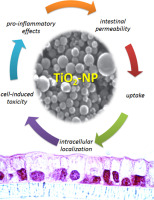当前位置:
X-MOL 学术
›
Food Res. Int.
›
论文详情
Our official English website, www.x-mol.net, welcomes your feedback! (Note: you will need to create a separate account there.)
In vitro intestinal epithelium responses to titanium dioxide nanoparticles.
Food Research International ( IF 8.1 ) Pub Date : 2018-10-12 , DOI: 10.1016/j.foodres.2018.10.041 Paola Pedata 1 , Giulia Ricci 1 , Livia Malorni 2 , Antonella Venezia 2 , Marcella Cammarota 1 , Maria Grazia Volpe 2 , Nunzia Iannaccone 2 , Vincenzo Guida 1 , Chiara Schiraldi 1 , Marco Romano 3 , Giuseppe Iacomino 2
Food Research International ( IF 8.1 ) Pub Date : 2018-10-12 , DOI: 10.1016/j.foodres.2018.10.041 Paola Pedata 1 , Giulia Ricci 1 , Livia Malorni 2 , Antonella Venezia 2 , Marcella Cammarota 1 , Maria Grazia Volpe 2 , Nunzia Iannaccone 2 , Vincenzo Guida 1 , Chiara Schiraldi 1 , Marco Romano 3 , Giuseppe Iacomino 2
Affiliation

|
Titanium dioxide (TiO2) is enclosed in many consumer products including pharmaceuticals, cosmetics, and foods. TiO2 (E171) is daily ingested as mixed nano- and submicron-sized particles since it is approved as a white colorant in Europe in a wide variety of food products, Noteworthy, the relevant risk assessment has never been satisfactorily concluded and growing alarms for human hazards deriving from TiO2 exposure are incrementally reported. The objective of the present study was to establish conceivable mechanisms by which nano-sized TiO2 particles affect physiological function of the intestinal epithelium layer. The well-established Caco-2 cell line differentiated for 21 days on permeable supports was used as a predictive model of the human intestinal mucosa to identify the biological response triggered by TiO2 particles. Exposure to 42 μg/mL TiO2 nanoparticles disrupted the tight junctions-permeability barrier with a prompt effect detectable after 4 h incubation time and wide effects on barrier integrity at 24 h. Transport and ultrastructural localization of TiO2 nanoparticles were determined by ICP-OES, TEM and ESI/EELS analysis, respectively. Nano-sized particles were efficiently internalized and preferentially entrapped by Caco-2 monolayers. Storage of TiO2 nanoparticles inside the cells affected enterocytes viability and triggered the production of pro-inflammatory cytokines, including TNF-α and IL-8. Taken together these data indicate that nano-sized TiO2 particles exert detrimental effects on the intestinal epithelium layer.
中文翻译:

体外肠上皮对二氧化钛纳米粒子的反应。
二氧化钛(TiO2)包含在许多消费产品中,包括药品,化妆品和食品。由于TiO2(E171)在欧洲已被广泛用于各种食品中,被批准为白色着色剂,因此每天以纳米级和亚微米级混合颗粒的形式被摄入。越来越多地报告了由于TiO2暴露引起的危害。本研究的目的是建立可想象的机制,通过该机制纳米级的TiO2颗粒会影响肠上皮层的生理功能。在渗透性支持物上分化21天的成熟建立的Caco-2细胞系被用作人肠粘膜的预测模型,以识别由TiO2颗粒触发的生物反应。暴露于42μg/ mL的TiO2纳米颗粒会破坏紧密的连接-渗透性屏障,在4 h的孵育时间后可检测到迅速的效应,并在24 h时对屏障的完整性产生广泛的影响。分别通过ICP-OES,TEM和ESI / EELS分析确定了TiO2纳米颗粒的转运和超微结构定位。纳米尺寸的颗粒被有效地内在化,并优先被Caco-2单层包裹。TiO2纳米颗粒在细胞内的储存会影响肠细胞的活力,并触发促炎性细胞因子(包括TNF-α和IL-8)的产生。这些数据加在一起表明,纳米尺寸的TiO2颗粒对肠上皮层产生有害作用。
更新日期:2018-10-12
中文翻译:

体外肠上皮对二氧化钛纳米粒子的反应。
二氧化钛(TiO2)包含在许多消费产品中,包括药品,化妆品和食品。由于TiO2(E171)在欧洲已被广泛用于各种食品中,被批准为白色着色剂,因此每天以纳米级和亚微米级混合颗粒的形式被摄入。越来越多地报告了由于TiO2暴露引起的危害。本研究的目的是建立可想象的机制,通过该机制纳米级的TiO2颗粒会影响肠上皮层的生理功能。在渗透性支持物上分化21天的成熟建立的Caco-2细胞系被用作人肠粘膜的预测模型,以识别由TiO2颗粒触发的生物反应。暴露于42μg/ mL的TiO2纳米颗粒会破坏紧密的连接-渗透性屏障,在4 h的孵育时间后可检测到迅速的效应,并在24 h时对屏障的完整性产生广泛的影响。分别通过ICP-OES,TEM和ESI / EELS分析确定了TiO2纳米颗粒的转运和超微结构定位。纳米尺寸的颗粒被有效地内在化,并优先被Caco-2单层包裹。TiO2纳米颗粒在细胞内的储存会影响肠细胞的活力,并触发促炎性细胞因子(包括TNF-α和IL-8)的产生。这些数据加在一起表明,纳米尺寸的TiO2颗粒对肠上皮层产生有害作用。



























 京公网安备 11010802027423号
京公网安备 11010802027423号